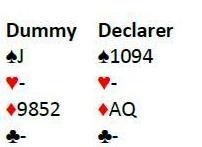Source: Learning Points by Steve Moese and Mike Purcell for http://www.cincybridge.com/
How does counting inform our choices as declarer? December 13, 2012
Consider the auction:
| You | LHO | Partner | RHO |
| 1 |
Dbl | Pass | |
| 2 |
Pass | 4 |
The End |
| Partner |
You |
What do we know?
Count HCP – We should have 25-26 HCP and LHO should have 12-14 HCP. That leaves RHO with 0-3 HCP. We also know that LHP has at least 3 cards in ![]() s (unless they use the so-called short club showing at least 2-cards).
s (unless they use the so-called short club showing at least 2-cards).
Count Length – Without seeing the hands, our jump to 2![]() shows 9-11 HCP and 4+
shows 9-11 HCP and 4+ ![]() s. We might hold 7 HCP if we have extra
s. We might hold 7 HCP if we have extra ![]() length and useful shortness in another suit (not
length and useful shortness in another suit (not ![]() s). All 7-8 HCP must be working – that is be in suits where we have length and not in opponents’ suits. Partner should have 4+
s). All 7-8 HCP must be working – that is be in suits where we have length and not in opponents’ suits. Partner should have 4+ ![]() s and 15-17 HCP. With more, partner would have made a Cue bid in
s and 15-17 HCP. With more, partner would have made a Cue bid in ![]() s.
s.
When dummy hits we count some more: Dummy has 16 HCP and declarer has 9 so we total 15. LHO has 12 (opening
bid) or more so RHO has at most 3 HCP.
LHO leads the ![]() 5.
5.
Counting Shape – using the rule of 11 (4th best leads) 11-5 = 6. There are 6 cards higher than the ![]() 5 out. We can see 4 of them, so RHO has only2 cards higher than the
5 out. We can see 4 of them, so RHO has only2 cards higher than the ![]() 5. Do NOT put in dummy’s
5. Do NOT put in dummy’s ![]() Q. Instead play low, and see what RHO does. If RHO goes up with the
Q. Instead play low, and see what RHO does. If RHO goes up with the ![]() K, don’t’ worry – that’s the only honor they can have. RHO has to have all the rest! Counting matters!
K, don’t’ worry – that’s the only honor they can have. RHO has to have all the rest! Counting matters!
Consider the auction:
| You | LHO | Partner | RHO |
| 1 |
Pass | Pass | |
| 2 |
Pass | 4 |
The End |
| Dummy |
Declarer |
What do we know?
Count HCP & Shape – LHO has at least 12 HCP and 3![]() s. You have 15-17 HCP and a good 6-card
s. You have 15-17 HCP and a good 6-card ![]() suit (A jump in the balancing seat shows a good suit and a good hand – a hand difficult to be after a simple overcall or double).
suit (A jump in the balancing seat shows a good suit and a good hand – a hand difficult to be after a simple overcall or double).
RHO has at most 4 HCP. Many respond with 5 HCP. Aggressive players strain to respond over a minor suit with an Ace or 2 Qs these days.
Partner must have 10-11 HCP, a good fit for ![]() s and perhaps some values in the
s and perhaps some values in the ![]() suit, and likely no biddable suit of their own. There has to be a reason partner did not overcall or double the opening bid.
suit, and likely no biddable suit of their own. There has to be a reason partner did not overcall or double the opening bid.
LHO leads the ![]() 2, which indicates RHO has 3 higher
2, which indicates RHO has 3 higher ![]() s. Winning and leading a small
s. Winning and leading a small ![]() to the
to the ![]() 7 won by RHO with the
7 won by RHO with the ![]() A. RHO has no more High Cards. No matter what RHO returns we will lose not more than 2
A. RHO has no more High Cards. No matter what RHO returns we will lose not more than 2![]() s and 1
s and 1![]() . We can finesse in
. We can finesse in ![]() s with confidence.
s with confidence.
Say RHO returns the ![]() 10. We cover with the
10. We cover with the ![]() J and LHO can now win their
J and LHO can now win their ![]() Q. If they continue
Q. If they continue ![]() our K sets up. If they switch we lead a
our K sets up. If they switch we lead a ![]() to hand, finesse the
to hand, finesse the ![]() K and drop a
K and drop a ![]() loser on the
loser on the ![]() A. Voila! Counting makes iffy plays into sure plays.
A. Voila! Counting makes iffy plays into sure plays.
Here is a classic.
| You | LHO | Partner | RHO |
| 1 |
Pass | Pass | |
| 2 |
Pass | 4 |
The End |
| Dummy |
Declarer |
We bid to a close game (close games always hone our declarer skill 😆 ). LHO leads the ![]() 2, and RHO wins the
2, and RHO wins the ![]() A.
A.
Count Winners & Losers – We have 3 winners & 4 losers and lots of work to do.
Count HCP – we have 25. RHO has at most 4. LHO has at least 11.
When RHO returns the ![]() 3, what do we play and why? RHO cannot have even one more J! Since LHO must have the
3, what do we play and why? RHO cannot have even one more J! Since LHO must have the ![]() K, finessing here is wrong. The only play that makes sense is to win the
K, finessing here is wrong. The only play that makes sense is to win the ![]() A. Either the
A. Either the ![]() K falls singleton (it happens) or we will eliminate
K falls singleton (it happens) or we will eliminate ![]() s and
s and ![]() s before throwing LHO in with the
s before throwing LHO in with the ![]() K (a losing
K (a losing ![]() goes away on the
goes away on the ![]() A). If the trump are 2-2, LHO will have to give us a
A). If the trump are 2-2, LHO will have to give us a ![]() trick or a ruff/sluff. With LHO on lead → with the
trick or a ruff/sluff. With LHO on lead → with the ![]() K, the
K, the ![]() loser goes away unless LHO has a 3rd trump. Either way we makeour game. You play so nicely!
loser goes away unless LHO has a 3rd trump. Either way we makeour game. You play so nicely!
Ready for another example counting HCP?
| You | LHO | Partner | RHO |
| 1 |
1NT* | 3 |
Pass |
| 4 |
The End | ||
| *= 15-17 HCP |
| Dummy |
Declarer |
The opening lead is the ![]() J.
J.
Count HCP – Dummy has 12. Declarer has 13. LHO has 15. RHO has 0!!!
Armed with the knowledge that LHO has every remaining honor you can play double dummy (like an open book). Finesse the ![]() Q. Play the
Q. Play the ![]() A pitching the
A pitching the ![]() 10. Ruff the remaining
10. Ruff the remaining ![]() to eliminate the suit.
to eliminate the suit. ![]() 3 to dummy. If LHO ducks, play the
3 to dummy. If LHO ducks, play the ![]() 10 to finesse the
10 to finesse the ![]() J. If LHO wins
J. If LHO wins ![]() A, finesse any return. If LHO mistakenly returns a
A, finesse any return. If LHO mistakenly returns a ![]() , ruff
, ruff
in dummy and pitch the ![]() Q from hand (eliminating your last
Q from hand (eliminating your last ![]() loser). Say LHO wins the
loser). Say LHO wins the ![]() A and returns the
A and returns the ![]() 5. Finesse play small from dummy and win cheaply in hand. Draw the last trump if necessary and play the
5. Finesse play small from dummy and win cheaply in hand. Draw the last trump if necessary and play the ![]() 8 to the
8 to the ![]() A. Finesse LHO for the
A. Finesse LHO for the ![]() Q. In all you lose 1
Q. In all you lose 1![]() and maybe 1
and maybe 1![]() .
.
See what counting can do!! (You might object that Dummy should double the 1NT bid and try to gain a big plus. No
argument – but this is an example for counting HCP, not doubling opponent’s indiscretions, or bad defensive
bidding).
One last HCP Counting example:
| You | LHO | Partner | RHO |
| 1 |
|||
| 1 |
Pass | 2 |
Pass |
| 4 |
The End | ||
| *= Limit Raise or better in |
|||
| Dummy |
Declarer |
The opening lead is the ![]() 4
4
Count the Lead – Rule of 11 says RHO [the ![]() bidder] has 4 cards higher than the
bidder] has 4 cards higher than the ![]() 4. RHO might have either a 4-card or 5-card
4. RHO might have either a 4-card or 5-card ![]() suit.
suit.
Count our HCP – Dummy has 8 (plus 3 Support Points for the singleton ![]() ). Declarer has 13. What were we thinking?
). Declarer has 13. What were we thinking?
Count RHO’s HCP – RHO Cashes the ![]() AK and the
AK and the ![]() A (Thank you for the favor) in quick order, then switches to a trump. With 3 losers already, we need the
A (Thank you for the favor) in quick order, then switches to a trump. With 3 losers already, we need the ![]() K to be with RHO too. Duck the
K to be with RHO too. Duck the ![]() and win cheaply in dummy. Repeat the
and win cheaply in dummy. Repeat the ![]() finesse until we capture the
finesse until we capture the ![]() K. Now we have to figure out how to find the
K. Now we have to figure out how to find the ![]() Q. Is it a 2-way guess?
Q. Is it a 2-way guess?
NOT AT ALL!
Review LHO’s HCP Count – RHO has shown up with the ![]() K,
K, ![]() A, &
A, & ![]() AK – that’s 14 HCP. Quick – check their
AK – that’s 14 HCP. Quick – check their
convention card! No fooling – what is their opening 1NT range? If 15-17 then RHO cannot hold the ![]() Q – RHO would have opened 1NT instead of 1
Q – RHO would have opened 1NT instead of 1![]() . If it’s 12-14, the RHO has to have the
. If it’s 12-14, the RHO has to have the ![]() Q because they did NOT open 1NT! And you thought counting was boring! (Raising to 4
Q because they did NOT open 1NT! And you thought counting was boring! (Raising to 4![]() on overcaller’s hand is aggressive. It’s good to be kind when giving feedback!).
on overcaller’s hand is aggressive. It’s good to be kind when giving feedback!).
